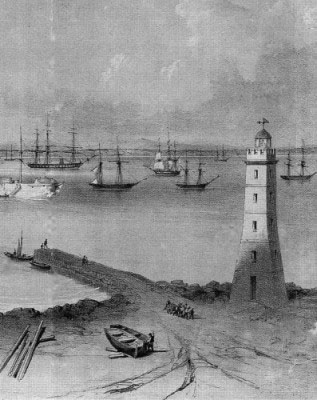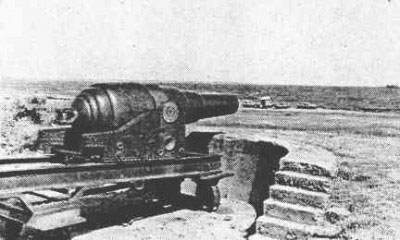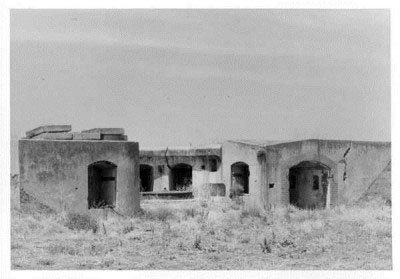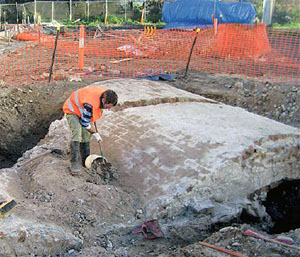Fort Gellibrand is located on Battery Road near Point Gellibrand at the southernmost tip of the Williamstown peninsula as it juts into Hobsons Bay and Port Phillip Bay.
Fort Gellibrand is of historical importance to Victoria for its association with the development of defence strategies for the colony in the nineteenth century, and for its association with the convict hulk period of the penal system in the colony.
Gellibrand’s Point was named after Joseph Tice Gellibrand, a lawyer and principal of the Port Phillip Association who drew up the treaty used by John Batman to purchase Port Phillip from the Aborigines in 1835. A 30-metre stone jetty was built by convict labour in 1838 where Gem Pier now stands. A wooden lighthouse tower was constructed in the early 1840’s and later replaced with a bluestone tower.

From the 1850s to the turn of the century a series of coastal defensive works were built in the Colony of Victoria in response to a perceived threat of attack from hostile warships.
The Point Gellibrand shore batteries were first developed as part of an immediate defensive system for the city and port of Melbourne. The strategy for the defence of the port of Melbourne at this time was based on a number of shore batteries inside Port Phillip Bay.

The first permanent battery was built by penal labour on Gellibrand’s Point in 1855. Convicts from the hulks moored offshore were employed on these works and accommodated in an old military barracks at the Fort. The buried central magazine at the Fort dates from this period. Further gun emplacements were added by private contracts, along the foreshore in the 1860’s.
The technology of artillery was developing rapidly in this period and the batteries were changed to accept, and defend against, new types of guns. Improvements were made to the Point Gellibrand batteries in 1871.

The most expansive period of building of shore defensive works in the Colony was the late 1880s and early 1890s. By this stage the primary defences of Port Phillip were located at the heads, but Fort Gellibrand batteries were also upgraded in this phase. Fort Gellibrand contained up to nine guns – some of which were ‘disappearing’ guns that would roll back to a defilade position to be reloaded.
The citizens of Melbourne obviously thought they had something worth protecting. By 1887, when the fortification’s armaments had added to them the provision of armed Harbour Trust boats, torpedo boats, minefields, searchlights, floating batteries, plus patrol vessels and telegraph wires for early warning. Melbourne was rated ‘the best defended commercial city of the Empire’.
But not all Melburnians were so pleased about state of defences. There were numerous close calls with passing ships during firing practice. The Williamstown Chronicle of 9 August 1902 reported that a ‘deputation from the Williamstown Town Council and local residents called on Sir William Lynn, the Acting Minister for Defence, regarding the damage to property brought about by the firing of the guns at the Fort. The delegation complained that the concussion from the guns “broke windows, cracked walls and in some instances injured the foundations of buildings.” Some 42 years later the same newspaper reported in July 1944 that claims for damages to property caused by the gun fire could now be lodged.
The importance of the Fort batteries declined from the 1890s, when they were effectively replaced by new facilities at Queenscliff and Point Nepean, but they were used for gunnery practice up until the 1920s. Commonwealth activity resumed from the 1930s to the late 1940s with the adaptation and use of the site for use as an artillery test range. A number of buildings were added to the area around the Drill Hall during this period.
The Sydney Morning Herald reported in September 1941 that a 25 pounder howitzer manufactured at Maribyrnong was test fired from the Fort. On successful completion of the test firing the guns were officially handed over from the Minister for Munitions to the Minister for the Army and entered into service.
Coastal artillery was disbanded after World War II when it was accepted that aircraft provided an effective and flexible solution to coastal and port defence, while hostile aircraft were capable of neutralising coastal batteries. In the years following World War II many of the emplacements and facilities at Fort Gellibrand became derelict.

A refurbishment program in the 1990’s saw many of the derelict emplacements removed or buried and replicas of the emplacements from the 1870’s were constructed.
The Fort Gellibrand site also contains physical evidence from the period when convict hulks were moored off Point Gellibrand. From 1854 five prison hulks were moored just offshore.
Some of the convicts from the hulks were employed in quarrying and building activity in a number of bluestone quarries along the shoreline, producing both mass stone and finished stone for government projects within the reserve and buildings in the town of Williamstown. One obvious area of shallow quarrying remains visible to the south west of the Fort.
The current road along the shore is thought to follow the line of the tramway built by the convicts to facilitate movement of stone. Convict quarries elsewhere along the shore in front of the Fort and elsewhere at the Point, have since been filled in.
Treatment of prisoners on the hulks was harsh. In 1857 Inspector General of Penal Establishments in Victoria John Price was attacked at Point Gellibrand by convicts from a working party and died of his injuries. The brutality of the hulk system was given as a reason for the attack in subsequent Government inquiries.
Today, the Fort is home to a reserve commando unit of the Australian Army – 2 Commando Company of the 1st Commando Regiment. The Fort is also a historic site containing the only remaining visible physical evidence of the system of four battery positions at Point Gellibrand from the 1870’s period.
In January 2011 a brick bunker and tunnel were uncovered when an underground rainwater tank was being installed at the adjacent cricket club. It is believed that the bunker was constructed in the late 1850s and it was probably used to store artillery rounds for the ‘Right Battery’.
A series of vaulted chambers has subsequently been uncovered and is presently being excavated and assessed. Heritage Victoria senior archaeologist Jeremy Smith said “the more we dig, the more we find. As weeks have progressed, it’s clear that there’s a whole network of fortification structures buried there.”
“We’re very confident that this is the oldest defence installation that’s survived in Victoria – it’s almost unique really,” Mr Smith said. “It’s a very significant find, potentially nationally significant.”

Contact Marcus Fielding about this article.






